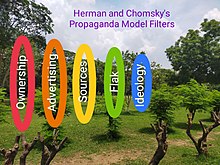
Back نموذج الدعاية Arabic উদ্দেশ্যপ্রণোদিত প্রচারণা প্রতিমান Bengali/Bangla Model propagandy Czech Model propaganda Welsh Propagandamodell German Modelo de propaganda Spanish مدل پروپاگاندا Persian Propagandamalli Finnish Modèle de propagande French Modello di propaganda Italian
This article needs additional citations for verification. (March 2023) |
The propaganda model is a conceptual model in political economy advanced by Edward S. Herman and Noam Chomsky to explain how propaganda and systemic biases function in corporate mass media. The model seeks to explain how populations are manipulated and how consent for economic, social, and political policies, both foreign and domestic, is "manufactured" in the public mind due to this propaganda. The theory posits that the way in which corporate media is structured (e.g. through advertising, concentration of media ownership or government sourcing) creates an inherent conflict of interest and therefore acts as propaganda for anti-democratic elements.

First presented in their 1988 book Manufacturing Consent: The Political Economy of the Mass Media, the propaganda model views corporate media as businesses interested in the sale of a product—readers and audiences—to other businesses (advertisers) rather than the pursuit of quality journalism in service of the public. Describing the media's "societal purpose", Chomsky writes, "... the study of institutions and how they function must be scrupulously ignored, apart from fringe elements or a relatively obscure scholarly literature".[1] The theory postulates five general classes of "filters" that determine the type of news that is presented in news media. These five classes are: ownership of the medium, the medium's funding sources, sourcing, flak, and anti-communism or "fear ideology".
The first three are generally regarded by the authors as being the most important. In versions published after the 9/11 attacks on the United States in 2001, Chomsky and Herman updated the fifth prong to instead refer to the "War on Terror" and "counter-terrorism", which they state operates in much the same manner.
Although the model was based mainly on the media of the United States, Chomsky and Herman believe the theory is equally applicable to any country that shares the basic economic structure and organizing principles that the model postulates as the cause of media biases.[2] Their assessment has been supported by a number of scholars and the propaganda role of the media has since been empirically assessed in Western Europe and Latin America.[3]
- ^ Chomsky 1989, p. [page needed].
- ^ "A selection of Chomsky". February 25, 2007. Archived from the original on February 25, 2007.
- ^ Klaehn, Jeffery (2018). Pedro-Carañana, Joan; Broudy, Daniel (eds.). The Propaganda Model Today: Filtering Perception and Awareness. doi:10.16997/book27. ISBN 9781912656165. S2CID 158190603.
